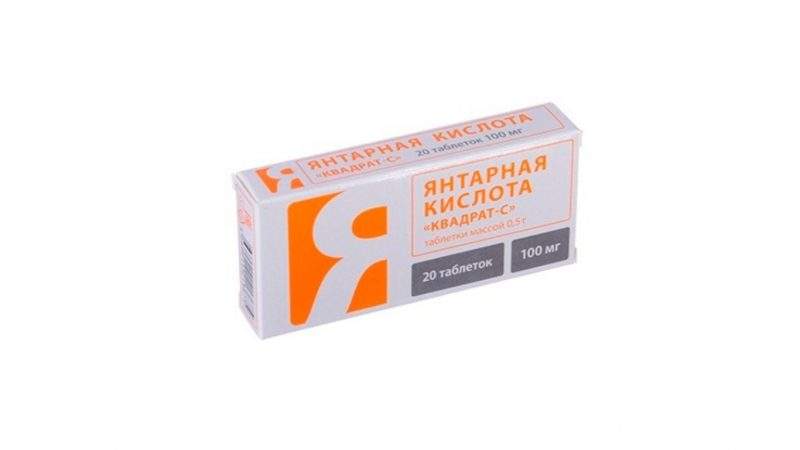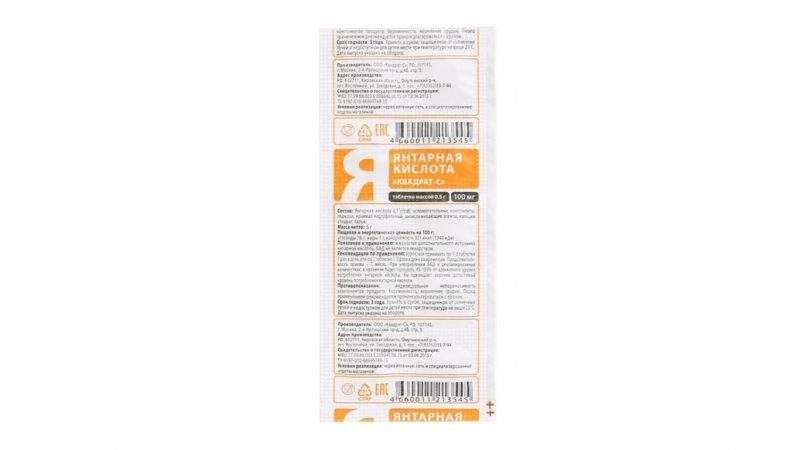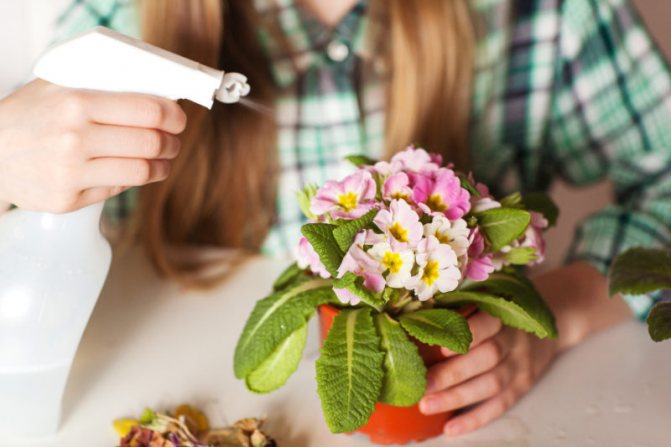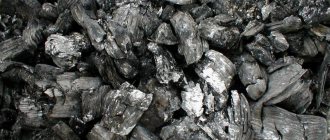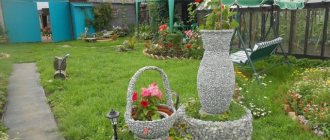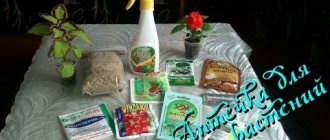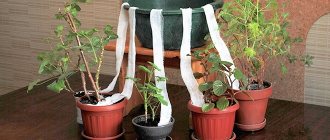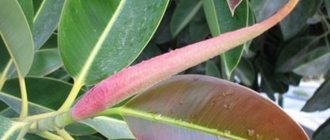Succinic acid for plants, including indoor plants, is used very often. It is a growth regulator, an anti-stress drug, and a normalizer of the natural microflora of the soil. How to use succinic acid for home flowers?
Succinic acid is a good growth stimulant, it accelerates the development of plants and increases the yield. It helps the plant to better absorb nutrients from the soil, as well as adapt to adverse conditions, and recover faster after transplanting. Unfavorable conditions - heat or cold, drought or high humidity - harm plants, succinic acid helps to resist such influences.
Properties and composition of succinic acid
Structure:
Succinic acid is ethane 1,2-dicarboxylic substance. Consists of colorless crystals, soluble in alcohol, ether or water. In its natural environment, it contains:
- In the coal with a drill;
- In organisms of the animal world;
- In the vegetable sphere;
- In amber.
It is obtained by an artificial method using a unique treatment of maleic anhydride. The result is a white powder that does not have aromas. This substance is an excellent stimulant for the growth of all types of plants.
Succinic acid for plants
Properties:
- Fertilizer decomposes in the soil;
- Does not harm the environment;
- Improves flower growth;
- Helps to assimilate nutrients from the soil;
- Plants with its help cope with stress;
- It is able to normalize the usual soil microflora;
- Flowers after processing are more resistant to the adverse effects of nature;
- If you fertilize the roots, then their growth will increase markedly;
- If fertilizer is applied to young stems, their growth will increase;
- Reanimates plants;
- If you process cuttings or seeds, you can be sure that they will all sprout and their resistance will increase;
- Inflorescences increase when spraying during the growing season;
The need for application:
- If the stems of the plant are weakened and become thin.
- Flowers do not fully receive all the trace elements they need from the soil.
- If plants are exposed to stressful situations: transplant, drought.
- The roots of the flowers cease to grow.
- Planted seeds or cuttings do not sprout.
- Flowers do not have inflorescences.
Description
The product of processing natural material, which is mined in the waters of the Baltic Sea, is called succinic acid, which is a colorless crystal. Easily soluble in water and alcohol. Produced in powder or tablet form.

succinic acid
Succinic acid for indoor plants helps in recovery after transplanting, or under adverse conditions. It is a growth regulator.
Due to its beneficial properties, the acid has gained high popularity among flower growers.
How to prepare the solution?
A solution of succinic acid is used for fertilization.
Step-by-step instructions for preparing the mixture:
- It is necessary to prepare the components for preparing the solution: succinic acid, warm water.
- Wear rubber gloves and a cloth bandage.
- To prepare a 0.01% solution, you need to take 1 g of the drug and develop it first with 100 ml of warm water, and then bring the volume to 1 liter by gradually pouring in cold water.
- For the manufacture of 0.02% mixture, you will need ready-made 0.01% and 200 ml of cold water.
- To get a 0.05% solution, you need to take a ready-made strong infusion of boric acid 500 ml and dilute it to a volume of 1 liter with cold water.
- If the dosage was slightly exaggerated, there will be nothing wrong with the plants, since the drug is completely safe for them.
- The mixture should be stored for no more than 3 days.
When and how often flowers should be watered
Succinic acid cannot harm the flowers in any way, but it is still recommended to use it no more than 3-5 times a month. This is especially necessary if the plant has begun to wither, has become fragile, when it is required to strengthen its root and ground part. The use of this tool is important for improving growth and increasing the resistance of flowers to negative environmental factors (sun, wind, cold, etc.).
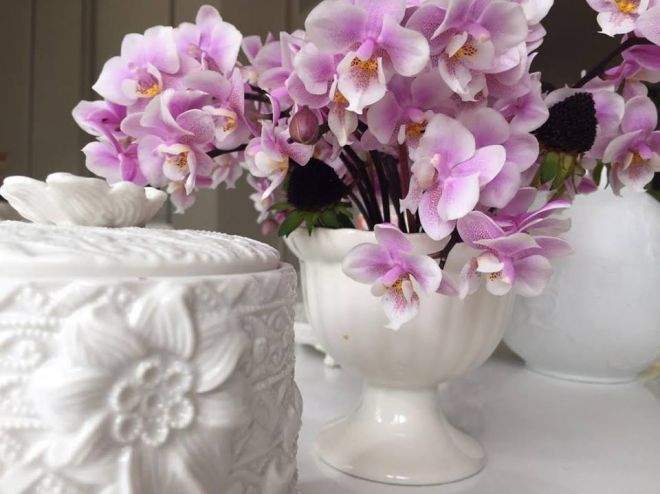

Succinic acid improves plant health
Garden plants are best watered in the evening when the sun is no longer active. So they will dry out more slowly, and the drug will work much more effectively.
For home flowers, there is no difference when they are watered, the main thing is not to leave them on the window after processing.
Plants are especially acutely in need of succinic acid in spring, when they are practically deprived of all their strength. To strengthen them, it is advisable to use the drug 2-3 days before watering the flowers with plain water. It is very useful to apply it immediately after planting (seedling treatment) and before their flowering (April-September).
What you need to work
You need to prepare:
- succinic acid in the form of powder (about 50 g) or tablets (10-15 pcs.);
- clean water - from 5 to 10 liters;
- sprayer;
- a small watering can;
- glass;
- spoon;
- gloves;
- glasses;
- a cosmetic cotton swab or piece of gauze.
General rules for working with the drug
Despite the safety of the drug, it is advisable to work with it with gloves and glasses. It is important to avoid contact with the mucous membranes of the eyes and skin. If this happens, you must immediately rinse them with plenty of clean water. This will help prevent inflammation and redness of the skin.


Most often, the drug can be purchased in pill form.
During the preparation of the solution, it is not allowed to be near children. It is necessary to dilute the powder immediately before using it. The leftovers of the funds are stored for no more than 3 days in a cool place, otherwise it will not be so useful. Despite its effectiveness, watering with this flower acid cannot replace standard fertilization. Therefore, it is very important to use it in combination.
Store undiluted acid at a temperature not exceeding 25 ° C. The room must be dry and dark. The presence of children, food and medicine in the immediate vicinity is not allowed.
Read with this article: How banana peels save houseplants
Methods for using the solution
Treatment of plants with a solution of succinic acid is possible at all stages of their development. There are several options for it:
- rubbing leaves;
- spraying;
- watering the root part;
- soil nutrition.
Ideally, you need to go through all these steps to take full care of your flowers. You can do this not at once, but after a week break, but preferably in the same order as indicated.
When leaving, keep in mind that the higher and more luxuriant the plant, the more solution it will need for it.
How to prepare a concentrate
To obtain the initial concentrate, dissolve 1 g of powder in a glass of warm water. It is very important that nothing remains of the dry ingredient, it should not settle to the bottom. Therefore, before watering the flowers with succinic acid, stir the composition well and, if necessary, whisk it. Next, you will need to add to it such an amount of water at room temperature, which will allow you to get a solution of the desired concentration.
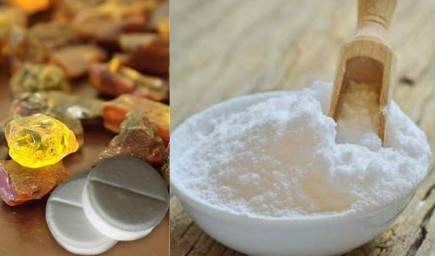

Powder or tablets are diluted in water
It is not at all necessary to dilute the solution with water, the initial one, prepared according to the proportions indicated in the table, is quite enough:
| № | purpose | Substance volume (in grams) | Water volume (liters) |
| Rubbing leaves and stems | |||
| Spraying | |||
| Watering the root part | |||
| Soil nutrition |
Most of all, the soil needs succinic acid; the minimum concentration is used to wipe the leaves and stems.
The prepared solutions can be diluted with water, but not more than 5 liters per 1 liter of concentrate, otherwise there will be no effect. This is quite enough to scare off beetles, caterpillars, slugs.
Processing in the bud formation phase is carried out with a 0.002% composition (prepared according to the table above). A solution at this concentration can be used for any of the purposes listed in the same table. During and after flowering, the concentration for spraying should be 2-3 times higher than usual. In order to reanimate the plants, it is necessary to water shoots, leaves and roots at the rate of 0.25 g of succinic acid (1 tablet) per 1 liter of water.
VIDEO: Succinic acid for orchids is a real doctor
How to use an already finished product
For preventive purposes, the corresponding areas are treated with the resulting solution. You should start watering the flowers from the leaves, then move on to the stems, and then spray the entire plant. The final stage is the processing of the root part and the soil near it.
The order of work is usually as follows:
- Rubbing leaves and stems
This can be done with a cotton pad or gauze cut. It is well moistened in the composition and, without squeezing, they pass from the top of the plant to the bottom. At the same time, movements should be circular and smooth, so as not to injure the plant. For convenience, you can hold a leaf or stem at the base with your palm. Then he needs to be allowed to dry.
- Spraying
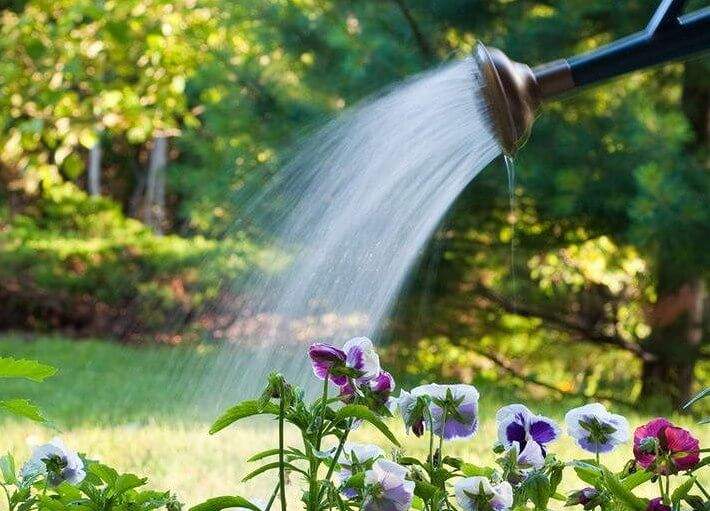

Outdoor plants can be watered and sprayed at the same time from a garden watering can
To do this, use a hydraulic or manual sprayer. The latter is quite enough when processing home plants, but in the garden you cannot do without the first. If the flowers have inflorescences, you need to try not to fall on them, otherwise they may wither. Between such processing, a pause of 3-4 weeks must be made. Eyes must be protected with goggles while working.
- Watering the root part
It is carried out from a regular watering can. For home flowers, it should be smaller, and for garden flowers, more. It is tilted at an angle of 45 degrees and, without touching the stem, the soil is moistened. Watering flowers with succinic acid, do not pour out the entire volume at once, you must do it slowly, evenly distributing the liquid over the entire surface around the plant.
- Soil nutrition
Before that, it should be loosened a little. A diameter of 20-25 cm around the bush will be enough. It is very important that the solution penetrates deep into the ground, at least 5-10 cm. About this distance from the surface of the ground are the roots of most flowers. Therefore, you can make depressions in it and partially fill them with concentrate. For 1 time it needs about 2-3 liters.
Using a solution for watering flowers with succinic acid in tablets or powder, you should not avoid feeding with special and standard fertilizers (humus, ash, products based on vermicompost). Only in this way will the plant remain healthy for a long time and delight you with its appearance, and some even with its aroma.
VIDEO: Methods for using succinic acid
Succinic acid is a product obtained from natural amber processing. It is mined at the bottom of the Baltic Sea, but in small quantities this substance is an integral component of many plant and animal organisms. Its greatest concentrates are found in amber and brown coal.The special treatment of maleic anhydride makes it possible to obtain it in artificial conditions. The release of this acid is produced in the form of tablets or powder crystals, which are easily dissolved in alcohol, water or ether.
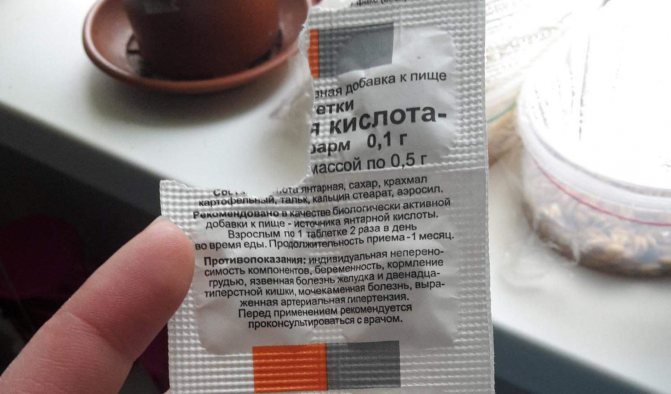

Succinic acid has a number of beneficial properties that stimulate plant growth and provide nutrition for indoor flowers, due to which it is widely used in home plant growing.
Substance treatment
Why process?
- Seeds:
- For their nutrition with useful substances means.
- For their resistance to temperature extremes.
- For faster germination.
- For stronger seedlings.
- Petioles:
- For additional nutrition of their root system.
- Reanimates damaged areas of the petioles.
- Resistance to various temperature extremes increases.
- Plants in general:
- To adapt it to a new place after transplanting.
- For recovery from drought or high humidity.
- To improve growth.
- For more harvest.
- For abundant flowering.
How to process?
Soaking seeds in succinic acid
Seeds:
- Seeds in horticulture are usually soaked in this substance.
- A mixture is made: 1 tablet is placed in a container with water. You will need 1 liter of liquid.
- The seeds are placed in this mixture and left there for 12-24 hours.
- The seeds must be pulled out and dried well.
- After drying, they can be planted in prepared soil.
- Before planting, potato seeds are not soaked in the product, but sprayed with it. After, they are placed in a plastic bag.
Cuttings:
- To begin with, cuttings are cut.
- A 0.02% solution of succinic acid is made.
- The solution is poured into a container.
- Cuttings should be placed there by 2 cm.
- The cuttings remain in the prepared mixture for several hours.
- After processing, they are dried and you can proceed to planting.
Plants:
- They are sprayed after suffering stress.
- You will need a 0.02% solution.
- They are sprayed with leaves and roots.
- After treatment, the plants will begin to recover quickly.
Roots:
- If there are problems with the roots of flowers, then use a 0.05% solution of the drug.
- They must be soaked in it for 6 hours.
- After processing, they do not need to be dried, but are immediately planted in prepared soil.
Spraying plants with succinic acid causes re-flowering
Seedling:
- The product is sprayed with seedlings prepared for planting.
- For the procedure, you will need a 0.02% solution.
- Spraying with the drug should be done in the evening or morning.
For flowering:
- In order for the flowers to please with flowering more than once, they are sprayed with a 0.02% solution of the drug.
- This should be done periodically 1-2 times a week.
- When the plants have faded, they are sprayed with a more concentrated solution.
How to use YAK for feeding?
Succinic acid for the treatment of all cultures without exception is used in liquid form, therefore, there are three main methods of its use:
- Soak.
- Irrigation.
- Watering.
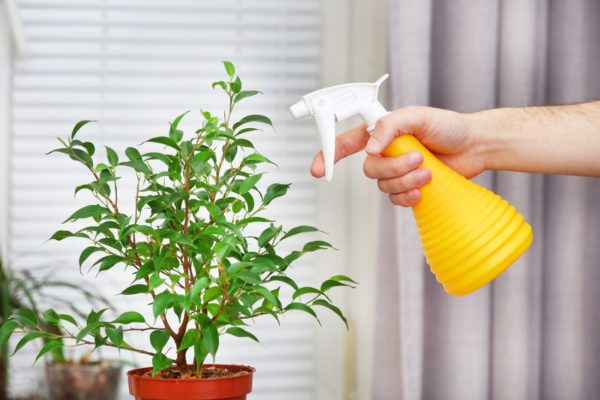

A detailed description of each method is considered in the table below.
| Method of use | Characteristic |
| Soak | Soaking YaK in a solution (in any of the options a weak solution is used) can be seeds, cuttings, the root part of plants. In the case of seed, after soaking, it needs to be dried. An exception is made only in one case, when the seeds germinated during the soaking process. In addition, it should be borne in mind that the seeds should not be stale. The soaking solution is made from 1000 ml of water and 0.4 g of acid. Soaking time is different. For seeds, it is several days, for cuttings a day, for soaking the roots of a plant, even one hour will be enough. |
| Irrigation | Spraying allows not only to accelerate the growth of plants, but also to strengthen them, and also contributes to the formation of new shoots. This is the best way to handle it.It is through spraying that the plant receives the largest amount of eggs. This method has several nuances. First, a flowering plant should not be processed. Spraying is allowed either before or after the specified period. Secondly, it is necessary to carry out such treatment either in the early morning or in the evening after sunset, since there is a high probability that direct sunlight will leave burns on the treated plants. Spraying must be carried out with a weak hydrosolution. The concentration of succinic acid in it should be 0.01%. |
| Watering | To enrich the composition of the microflora of the soil in which the culture grows, as well as to make plants stronger, restore their defenses, accelerate growth and development, they are watered with an aqueous preparation based on YaK. Top dressing is prepared from 1 gram of the substance (2 tablets) and 5 liters of water. This strengthening procedure should be carried out twice a year, if necessary, more often. |
In order to achieve the maximum effect from the use of succinic acid, it is recommended to combine all three of the above methods.
Advice! If the composition of succinic acid comes into contact with the skin, it is recommended to wash the contaminated area with soap. In general, UC is not dangerous, but it can still cause irritation upon contact with sensitive skin.
Effect on plants
- Succinic acid acts as a plant stimulant.
- If you do the recommended dosages for the treatment, then it will have a positive effect.
- Treatment with a mixture of young shoots, leads to their strengthening and normal growth.
- The substance is able to stabilize the development and vital activity of the familiar microflora of the soil. This is important for areas that have been contaminated with toxic agents. Fertilizers destroy them by activating soil microorganisms.
- Delays the accumulation of toxins by plants.
- With its help, they get rid of the detrimental effect of man-made waste on the soil structure, while not polluting it.
- The product activates the processing of biological organic fertilizers.
- When pretreating seedlings and their further watering with the addition of this substance, it improves the resistance of plants to heat, frost, high humidity and drought.
- After processing, the flowers increase their immunity to various diseases.
- The chlorophyll coefficient in the leaves increases.
- The plant grows more intensively and their harvest is plentiful.
- By using this remedy, nitrogen build-up in flowers can be reduced.
- The drug cannot completely replace mineral fertilizers, but the resistance and natural standards of plant growth are improved.
- Succinic acid can increase the yield by 15-20%.
- In fruits, the content of various acids useful for the human body increases.

